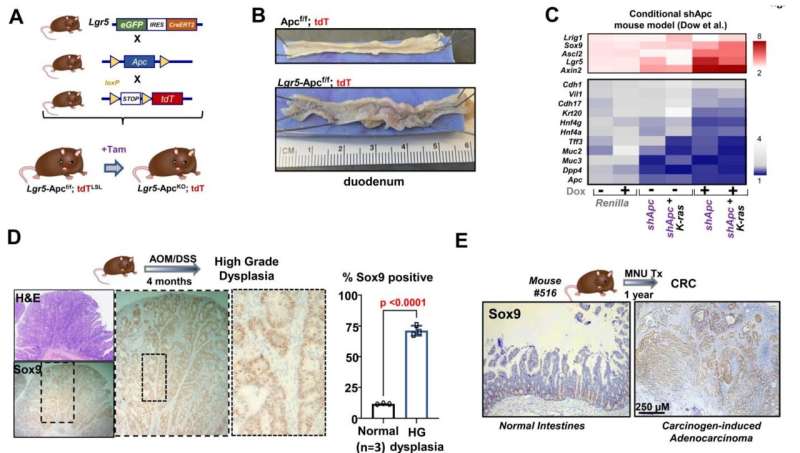This article has been reviewed according to Science X's editorial process and policies. Editors have highlighted the following attributes while ensuring the content's credibility:
fact-checked
peer-reviewed publication
trusted source
proofread
Sox9 protein enables molecular 'time travel' that can lead to colorectal cancer

Normally the lining of the colon forms a series of steep hills and valleys. At the surface, where the hills peak, are functional colon cells that do the organ's work of absorption and secretion. Deep in the valleys are stem cells that constantly renew those functional cells. New research from Dana-Farber Cancer Institute found that the cells in those valleys can go through a transition before cancer begins.
Using mouse models and tumor models called patient-derived organoids, they found that the cells undergo a type of molecular time travel that reverts them back to an embryonic state. Fetal genes that are silenced in adults are inappropriately turned on, endowing greater cellular flexibility. But instead of creating functional cells that migrate to the surface, they create immature, non-functional cells that clump together to form benign growths called adenomas. Over time, these adenomas can turn cancerous.
Over 80% of colorectal cancers show signs of mutations that are related to this immature state of impaired differentiation. The researchers also found that this molecular time travel depends on a protein called Sox9 and that blocking Sox9 in mouse models prevented adenoma formation, enabled cells to mature, and resulted in the death of pre-cancer cells. The work builds on previous research from the Sethi Lab at Dana-Farber suggesting that human colon cancer depends on Sox9.
Approximately 80% of colorectal cancers harbor mutations that interrupt cellular differentiation, resulting in the buildup of immature pre-cancerous cells. These insights, however, have not resulted in clinically effective medicines. This study looks at what happens before the emergence of these mutations and finds not only evidence of fetal reprogramming that can initiate cancer, but also a protein, Sox9, that fuels that reprogramming. This and previous research from the Sethi Lab suggest Sox9 is a promising therapeutic target for colorectal cancer.
The paper is published in the journal Science Advances.
More information: Pratyusha Bala et al, Aberrant cell state plasticity mediated by developmental reprogramming precedes colorectal cancer initiation, Science Advances (2023). DOI: 10.1126/sciadv.adf0927. www.science.org/doi/10.1126/sciadv.adf0927


















